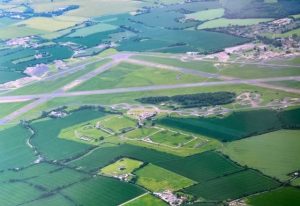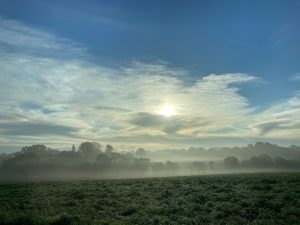Rebel with a cause
 Environmental campaigner Rosie Pearson
Environmental campaigner Rosie Pearson
Rosie Pearson is a fearless and tireless environmental campaigner for the beautiful North Essex countryside, its rivers, and its wildlife. An Essex girl born-and-bred, she has looked on with horror as huge tracts of the green landscape she knew and loved as a child disappear under concrete. However, she is hopeful that perhaps the tide is turning as the world begins to focus on preserving green spaces, restoring habitats, protecting ecosystems, replanting lost forests, and giving wildlife a chance.
For many years Rosie dreamt of creating a North Essex Woodland Corridor and now she and another Colne-Stour member, Tim Came, are part of a group talking to farmers about joining together to make this concept a reality.
“The aim is to create a wild corridor throughout this area because connected habitats are essential for wildlife to flourish.”
Already, around fifteen landowners between Wethersfield and Coggeshall have expressed interest. There is also an opportunity to link the unusually wooded hilltops between Coggeshall and Gosfield, and onwards towards Wethersfield, where three hundred acres has been purchased for rewilding by a company called Ground Control.
Rosie recently met up with inspirational environmentalist Mike Wadham who is spearheading a project known as The Big Green Internet to connect all the woodlands from Epping Forest to the North Sea. The target is to plant one hundred miles of tree corridors and half a million hedgerow whips over the next ten years. Included in the hedgerows will be heritage Essex apple and pear trees, and pollarded boundary oaks.
“It was really exciting to meet Mike – his enthusiasm is infectious” says Rosie. “He has council backing and he’s just getting on with it. In this area he is planting twenty-two thousand trees in hedgerows on a farm in Great Maplestead and virtually no land is being taken out of food production. Mike hopes to connect this scheme to Grays Farm, adjacent to the old Wethersfield Airfield.”
Wethersfield Airfield is now in the process of being sold by the Ministry of Defence and a battle looms over its future. The site was not considered suitable for housing by Braintree District Council in 2016, but there was no public consultation at the time as to what should happen to it. One only has to look at the old airfield Tempelhofer park in Berlin, with its old runways full of happy roller-skaters, and cyclists, and its green spaces full of dog walkers, picnickers and community gardens to see what could be possible. Indeed, local people have come up with a range of ideas that could bring jobs and tourism to the area if the airfield had wildlife walks, a visitor centre, cycle trails, horse riding trails, and a training centre for people working with nature, Now, however, there are plans for it to become the site of two mega-prisons capable of housing three thousand five hundred inmates.
“This make will make them the two largest prisons in Europe!”

Wethersfield Airfield
“The prisons proposed will be in open countryside where there is no infrastructure,” says Rosie. “The roads are narrow and pass through the historic villages of Finchingfield, Wethersfield and Sible Hedingham. Locals are understandably concerned about the construction traffic and traffic when the prison is up and running. The prison buildings themselves will be up to seventeen metres high, and therefore visible from a great distance, day and night, in this beautiful rural area – with its dark night skies.”
“The plan presented to the Ministry of Justice fails to mention the hundreds of species of birds, plants and invertebrates on the site, many rare or protected. The habitat is ‘open mosaic’ – the best kind of undisturbed habitat on previously used land, and is home to rare grasses and orchids. The plan does not mention the extraordinary heritage – the presence of the last remaining Cold War ‘Victor Alert’ station in Europe, a possible Roman Road, and the site of a Norman farm house. It is also one of the top twenty-five scoring airfields in a survey of four hundred carried out by Historic England – it probably should be listed. Nor does it talk about the cultural heritage of the area. Eric Ravilious lived in a house that looked up towards the hill where the prisons will be situated and indeed the whole area was much loved by the Great Bardfield artists.”
There is scope for rewilding the whole eight hundred hectare site and Rosie knows of two bidders who have already expressed interest in buying it, but cannot move forward due to the prisons. Rosie has joined a campaign group called Stop Wethersfield Airfield Prisons (SWAP) and has written to Dominic Raab to alert him to the fact that Ministry of Justice public consultation principles were breached, that the Ministry of Justice is ignoring its own guidelines for the location of prisons, and that the proposal is contrary to planning policies by affecting habitats, species and heritage.
“The MoJ’s guidelines state that a prison should be near jobs, homes, families and crime and have good access roads. This site is none of those things.”
“I know we need more prisons and more affordable housing in the UK and I am not against development per se. However I am driven by an inner sense of outrage and sadness whenever unnecessary or poorly thought-through proposals threaten our countryside and wildlife. My sense of justice also means that if something is done badly by the planning system, I can’t help but try to change it. I always try to propose a better alternative when I oppose a scheme.”
Indeed Rosie and a team of campaigners worked hard to engage with and suggest alternatives to council plans to build a huge ‘garden community’ called West Tey.
“Perhaps fortuitously, the West Tey proposal reared its head in 2010 when I was at home with small children and unable to work”, says Rosie. “Petra Ward, a stalwart CPRE and Colne-Stour campaigner and family friend, approached me about a campaign group to oppose these plans so we set up CAUSE – Campaign Against Urban Sprawl (in) Essex.

Proposed Site of West Tey
“West Tey really was a monster of a proposal.”
“At one point it grew to twenty-eight thousand homes – there was another so-called ‘garden community’ to the west of Braintree and one of up to nine thousand homes east of Colchester. They were sold to us by government, and the four councils behind them, as a solution to all of our housing needs. In fact, they were fraught with problems, and would not have resulted in affordable homes.”
CAUSE took its case to a planning inspector in 2018 and won. West Tey and West of Braintree were then rejected a second time in 2020.
“The East Colchester proposal just scraped through the system. Sadly, all the early ideals are long gone. Instead of a visionary, new way of doing things to reduce car use, such as cycle lanes, and trams, it will be served by a dual carriageway. I am afraid that the end result will be no different from the soulless car-dependent housing estates now springing up at Tollgate, and the costs are already spiralling, just as we warned.”
Indeed, the costs to the tax payer during the planning and inspection phase were eye-watering. CAUSE managed to raise £120k in order to pay for experienced consultants to present alongside them at the various hearings, whilst Rosie and the CAUSE volunteers put in six years of unpaid work. The councils on the other hand have spent £8 million on consultants. At every stage CAUSE tried to engage with the councils and bring positive solutions, but felt that they were brushed aside.
“The councils did everything they could to discredit our green Metro Plan alternative, so it was a great coup that the inspector recognized it as a valid scheme.”
“It was so frustrating – we tried to involve the whole community by holding two conferences that explored what good development looked like,” says Rosie. “I even flew out to Freiburg in Germany with my children to see what the exemplar urban design projects are really like, and visited Poundbury and Ebbsfleet Garden City. We had an informed view, but we were ignored at every opportunity. The campaign became antagonistic and we had no choice but to fight.”
In the process of campaigning Rosie made many connections and alliances, including lots of useful contacts via Twitter.
“It was clear to all of us that the planning system is very broken and that groups all over the country are fighting the same battles.”
So in April 2021 she co-founded the Community Planning Alliance, which now lists nearly six hundred community groups on its UK campaign map. The CPA, led by Rosie, has been mentioned many times in the national press and also in planning publications. It has a Facebook group, and is fast approaching 2,000 members. It has already submitted responses to national consultations and inquiries, mostly written by Rosie with input from the other committee members. “We are united by our desire to protect the environment and promote grassroots planning” says Rosie. It was no surprise to many therefore that on International Women’s Day in March this year Rosie was nominated by readers of The Planner magazine as one of their 2022 women of influence.
Recently the CPA has been drawing attention to the government housing target which seem to give as much weight to detached five bedroom high end housing as it does to affordable, eco or brownfield housing. Rosie has also been drawing people’s attention to a recent CPRE report “Beauty still betrayed – the state of our AONBs.” In the report Crispin Truman, CPRE chief executive, writes: “The fact that some of our most highly-prized areas of countryside are being lost to build more executive homes says a great deal about our planning system. Continuing with this ‘build and be damned’ approach just serves to line the pockets of greedy developers….doing next to nothing to tackle the affordable housing crisis. Rural communities are crying out for well-designed, quality and genuinely affordable homes in the right places. We know this kind of development is possible. To start building the right nature-friendly and low-carbon homes in the right places, we must see a swift change of tack from the government to put nature and countryside communities at the heart of any future Planning Bill.”
 Rosie’s enthusiasm and drive, and the way in which she backs up all of her thinking with rigorous research and analysis is impressive. She regularly publishes articles on her LinkedIn page, tackling meaty environmental issues affecting the local area such as the recently announced ’30-year Transport Strategy for the East, and the rush of planning applications for vast solar farms. She is regularly asked to contribute to Press and TV coverage of local planning issues and has a growing number of followers on social media. Whilst she has been surprised by some of the hostile reactions towards her efforts by council members, it has not put her off standing up for what she believes is right.
Rosie’s enthusiasm and drive, and the way in which she backs up all of her thinking with rigorous research and analysis is impressive. She regularly publishes articles on her LinkedIn page, tackling meaty environmental issues affecting the local area such as the recently announced ’30-year Transport Strategy for the East, and the rush of planning applications for vast solar farms. She is regularly asked to contribute to Press and TV coverage of local planning issues and has a growing number of followers on social media. Whilst she has been surprised by some of the hostile reactions towards her efforts by council members, it has not put her off standing up for what she believes is right.
“Our precious countryside and wildlife cannot defend itself – it needs all the help it can get.”
——————————————————————————————————-
You can follow Rosie and keep up with the campaigns as follows:
Twitter @RosieP4
https://www.linkedin.com/in/rosie-pearson-6a13784/
North Essex Wildlife Corridor
Rosie is Chairman of The Community Planning Alliance
www.communityplanningalliance.org.
@communityplann1
Community Planning Alliance: the grassroots group | Facebook
The Big Green Internet
